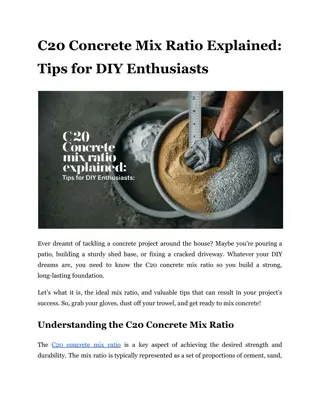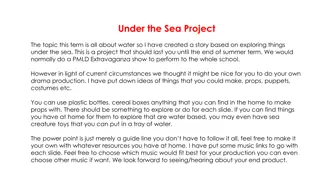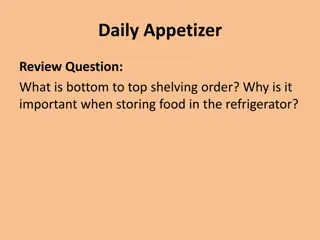
DIY Refrigerator Repair Tips_ Common Problems and Solutions
Learn easy DIY refrigerator repair tips to fix common problems like cooling issues, leaks, and strange noises. Save time and money today!n
Download Presentation

Please find below an Image/Link to download the presentation.
The content on the website is provided AS IS for your information and personal use only. It may not be sold, licensed, or shared on other websites without obtaining consent from the author. Download presentation by click this link. If you encounter any issues during the download, it is possible that the publisher has removed the file from their server.
E N D
Presentation Transcript
DIY Refrigerator Repair Tips: Common Problems and Solutions A refrigerator is one of the most important appliances in any home, and when it stops working correctly, it can lead to spoiled food and increased energy bills. While some refrigerator issues require professional help, there are several common problems that homeowners can troubleshoot and fix on their own. This guide provides DIY refrigerator repair tips for those looking to save money and time by handling simple repairs themselves. 1. Refrigerator Not Cooling Properly Overview: One of the most frustrating refrigerator problems is when it stops cooling properly. If your refrigerator isn t keeping food at the right temperature, it can lead to spoiled produce, dairy, and other perishables. Fortunately, this issue can often be fixed without the need for professional repair. Possible Causes: Dirty Condenser Coils: Condenser coils located at the back or underneath the refrigerator release heat and help cool the appliance. If they are clogged with dust and debris, the refrigerator can struggle to maintain the correct temperature.
Blocked Vents: Refrigerators rely on internal airflow to distribute cool air throughout the appliance. Blocked air vents can prevent proper cooling. Faulty Thermostat: If the thermostat isn t functioning correctly, it may fail to maintain the desired temperature inside the fridge. Damaged Door Seal: A cracked or worn-out door seal can allow cold air to escape, causing the fridge to work harder and resulting in inefficient cooling. DIY Solutions: Clean the Condenser Coils: Use a vacuum or coil cleaning brush to remove dirt and debris from the condenser coils. This will improve airflow and help your refrigerator cool more effectively. Check and Clean Vents: Ensure that vents inside the refrigerator are unobstructed. Clear any items blocking airflow to maintain optimal cooling. Test the Thermostat: Check the thermostat settings and adjust them if necessary. If the thermostat is malfunctioning, you may need to replace it. Inspect the Door Seal: Check the rubber door seal for cracks or gaps. If damaged, you can replace the door seal to restore the refrigerator s energy efficiency. 2. Refrigerator Leaking Water Overview: Water pooling inside or around the refrigerator is another common issue. If you notice a puddle of water on the floor or inside the fridge, it could be a sign of a clog or malfunctioning component. Possible Causes: Clogged Defrost Drain: The defrost drain carries excess water from the refrigerator s defrost cycle to a pan underneath the appliance. If it becomes clogged with food particles or ice, it can cause water to leak. Broken Door Seal: A damaged door seal can allow warm air to enter the fridge, causing condensation to form on the interior walls or pooling inside. Water Filter Issues: If your refrigerator has an ice maker or water dispenser, a clogged or malfunctioning water filter can cause water leakage. Frozen or Leaking Water Line: In refrigerators with ice makers or water dispensers, a frozen or leaking water line can cause water to pool around the appliance. DIY Solutions: Clean the Defrost Drain: To clear a clogged defrost drain, locate it under the refrigerator and use a pipe cleaner or flexible wire to dislodge any debris. You can also pour warm water into the drain to help clear any ice buildup.
Check and Replace the Door Seal: If the door seal is compromised, replacing it can prevent condensation and water leakage. Check the seal for any gaps or cracks and replace it if needed. Replace the Water Filter: If you notice leaks from the water dispenser or ice maker, check the water filter. If the filter is clogged or expired, replace it with a new one. Inspect Water Lines: If there is water pooling in the fridge or freezer area, check the water line for leaks or damage. Repair or replace any damaged sections of the water line. 3. Refrigerator Making Strange Noises Overview: It s normal for a refrigerator to make some noise, such as a hum from the compressor. However, if you start hearing unusual sounds such as buzzing, clicking, or rattling it could indicate a problem with a part of the refrigerator. Possible Causes: Condenser Fan Issues: The condenser fan helps dissipate heat. If the fan becomes clogged with dust or debris, it may start making strange noises. Evaporator Fan Problems: The evaporator fan circulates air throughout the fridge and freezer. If it becomes obstructed or malfunctioning, it may produce rattling or buzzing noises. Loose or Damaged Parts: Sometimes, loose components like the refrigerator shelves or trays can cause rattling sounds, especially when the fridge is running. Compressor Malfunction: If the compressor is malfunctioning, it can cause a loud humming or buzzing noise. This is typically a more serious issue and may require professional assistance. DIY Solutions: Clean the Fans: First, check both the condenser and evaporator fans for dirt or obstructions. Clean the fans and surrounding areas using a vacuum or soft brush to ensure smooth operation. Tighten Loose Parts: If you hear rattling noises, inspect the shelves and trays inside the refrigerator. Tighten any loose parts or replace damaged ones to prevent unnecessary noise. Check the Compressor: If you suspect a compressor issue, try to listen for any strange sounds coming from the bottom of the refrigerator. If you hear a constant buzzing or clunking sound, it may require a technician s help.
4. Refrigerator Not Dispensing Ice Overview: A refrigerator with an ice maker and dispenser can experience issues where the ice maker doesn t produce ice, or the dispenser fails to release it. This can be caused by several issues, from frozen water lines to a malfunctioning dispenser mechanism. Possible Causes: Frozen Water Line: If the water line to the ice maker freezes, it can prevent water from entering the ice tray, leading to no ice production. Clogged Water Filter: A clogged water filter can restrict water flow to the ice maker, preventing it from making ice. Faulty Ice Maker: If the ice maker is not functioning, it could be due to a broken motor or thermostat. Blocked Dispenser Mechanism: A malfunctioning or clogged ice dispenser mechanism can prevent ice from being dispensed properly. DIY Solutions: Defrost the Water Line: If the water line to the ice maker is frozen, turn off the refrigerator and allow the line to thaw. You can also use a hairdryer on a low setting to gently warm the line. Replace the Water Filter: If the filter is clogged, replace it with a new one to restore proper water flow to the ice maker. Inspect the Ice Maker: Check for any visible damage to the ice maker. If there s an issue with the motor or thermostat, replacing the ice maker may be necessary. Clear the Dispenser Mechanism: Clean the ice dispenser mechanism and ensure there are no ice blockages or debris obstructing the chute. 5. Refrigerator Smelling Bad Overview: If your refrigerator starts smelling bad, it could be caused by spoiled food, mold, or bacteria inside the fridge. Fortunately, this is often an easy fix. Possible Causes: Spoiled Food: Leftover food can quickly spoil and cause odors if not discarded in time. Dirty Drip Pan: The drip pan underneath the refrigerator can collect food spills and moisture, which can lead to foul smells if not cleaned regularly. Mold or Mildew: Moisture buildup in the refrigerator can lead to mold and mildew, especially in hidden areas like the door seals or under the shelves. DIY Solutions:
Clean the Interior: Empty the refrigerator and clean all surfaces with warm, soapy water or a vinegar solution. Don t forget to clean shelves, trays, and compartments. Clean the Drip Pan: Locate the drip pan under the refrigerator and clean it regularly to prevent odors. Remove any accumulated debris and moisture. Check for Mold: Inspect door seals and hidden areas for mold or mildew. Clean with a mixture of water and baking soda to remove odors and prevent future growth. Final Thoughts Many common refrigerator problems can be resolved with a bit of DIY effort. Regular maintenance, such as cleaning the condenser coils, replacing the water filter, and ensuring proper airflow, can help prevent major issues from arising. However, if you encounter problems that are too complicated or require specialized parts, it s best to call in a professional repair service. CLT Appliance Repairs offers expert appliance repair services, including refrigerator repairs, to help restore your appliance to peak performance. Site Article: DIY Refrigerator Repair Tips: Common Problems and Solutions (GP8)

![GET [✔PDF✔] DOWNLOAD✔ The Ultimate Burger: Plus DIY Condiments, Sides, and](/thumb/68033/get-pdf-download-the-ultimate-burger-plus-diy-condiments-sides-and.jpg)




















